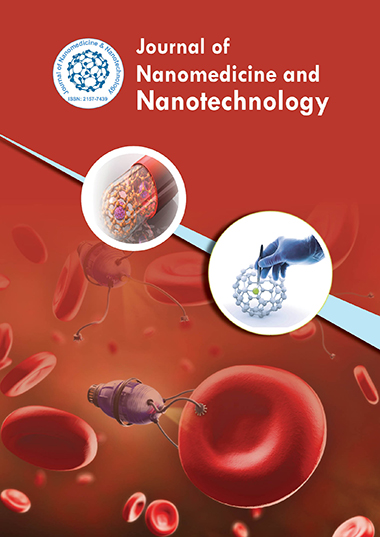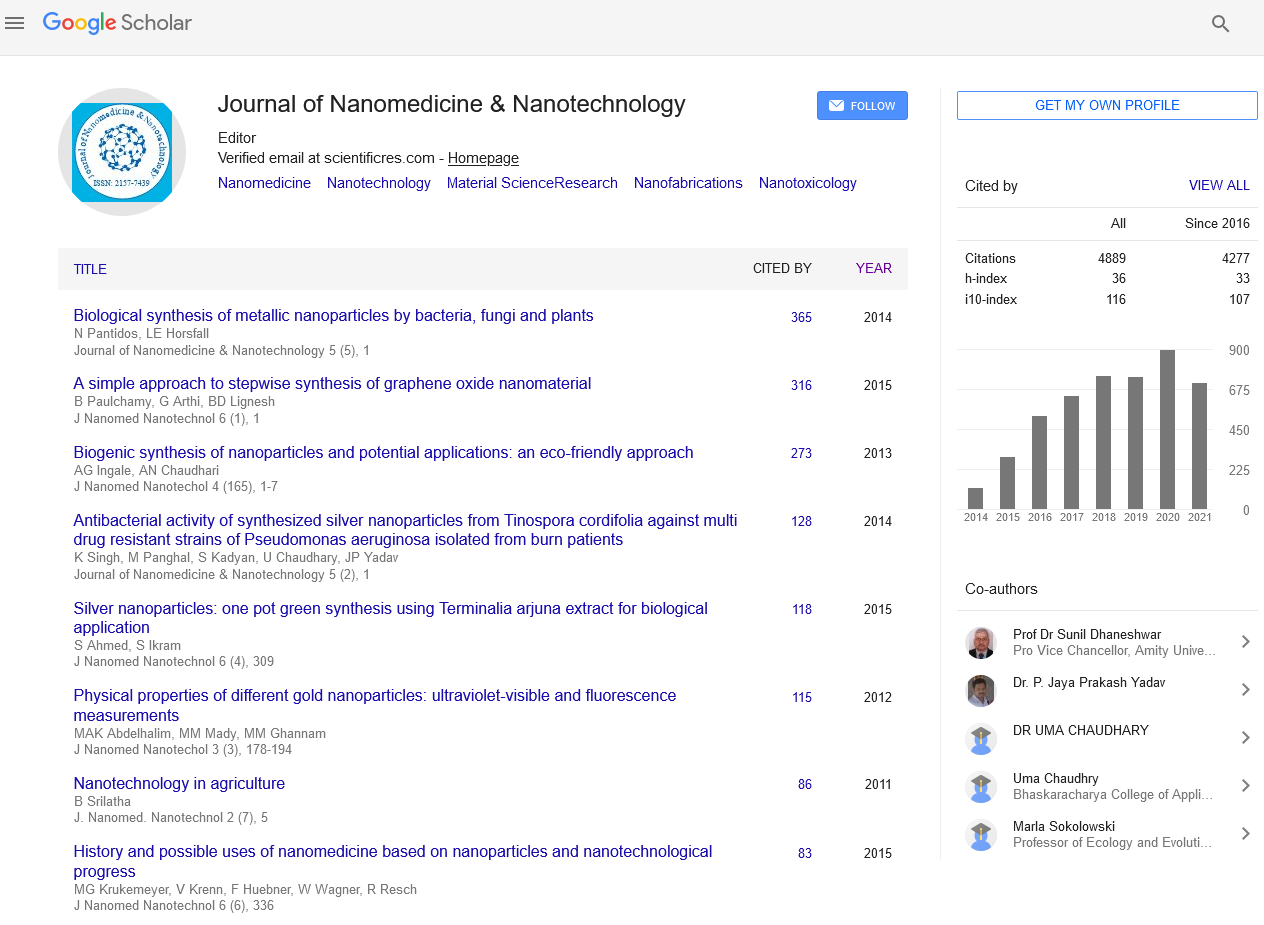Indexed In
- Open J Gate
- Genamics JournalSeek
- Academic Keys
- JournalTOCs
- ResearchBible
- China National Knowledge Infrastructure (CNKI)
- Scimago
- Ulrich's Periodicals Directory
- Electronic Journals Library
- RefSeek
- Hamdard University
- EBSCO A-Z
- OCLC- WorldCat
- SWB online catalog
- Virtual Library of Biology (vifabio)
- Publons
- MIAR
- Scientific Indexing Services (SIS)
- Euro Pub
- Google Scholar
Useful Links
Share This Page
Journal Flyer

Open Access Journals
- Agri and Aquaculture
- Biochemistry
- Bioinformatics & Systems Biology
- Business & Management
- Chemistry
- Clinical Sciences
- Engineering
- Food & Nutrition
- General Science
- Genetics & Molecular Biology
- Immunology & Microbiology
- Medical Sciences
- Neuroscience & Psychology
- Nursing & Health Care
- Pharmaceutical Sciences
Editorial - (2025) Volume 16, Issue 1
Magnetic Nanoparticles for Non-Invasive Real-Time Monitoring of Stem Cell Therapy
Gauthier Lefevre*Received: 01-Jan-2025, Manuscript No. jnmnt-25-28315; Editor assigned: 03-Jan-2025, Pre QC No. jnmnt-25-28315 (PQ); Reviewed: 16-Jan-2025, QC No. jnmnt-25-28315; Revised: 23-Jan-2025, Manuscript No. jnmnt-25-28315 (R); Published: 31-Jan-2025, DOI: 10.35248/2157-7439.24.16.768
INTRODUCTION
Stem cell therapy has emerged as a promising approach for treating a wide range of diseases, including neurodegenerative disorders, cardiovascular diseases, and spinal cord injuries. The ability of stem cells to differentiate into various cell types and promote tissue regeneration has garnered significant attention in regenerative medicine. However, one of the major challenges in stem cell therapy is the inability to monitor the cells after transplantation, especially in vivo. Magnetic nanoparticles (MNPs) offer a novel solution for non-invasive, real-time tracking of stem cells, providing valuable insights into their engraftment, migration, differentiation, and therapeutic efficacy. This article explores the use of magnetic nanoparticles for monitoring stem cell therapy, emphasizing their advantages, mechanisms, and future directions in clinical applications [1].
MAGNETIC NANOPARTICLES PROPERTIES AND FUNCTIONALITY
Magnetic nanoparticles are nanometer-sized particles composed of magnetic materials, such as iron oxide, cobalt, or nickel, which exhibit strong magnetic properties. The most commonly used magnetic nanoparticles in biomedical applications are superparamagnetic iron oxide nanoparticles (SPIONs). These nanoparticles are characterized by their superparamagnetism, which allows them to respond to an external magnetic field without retaining any magnetization once the field is removed. This unique property enables their use in various diagnostic and therapeutic applications, including magnetic resonance imaging (MRI), targeted drug delivery, and stem cell tracking. The surface of magnetic nanoparticles can be functionalized with biocompatible coatings, such as polyethylene glycol (PEG), to improve their stability, circulation time, and biocompatibility. These coatings also allow for the attachment of targeting ligands, enhancing the specificity of the nanoparticles for particular cell types or tissues. By combining these nanoparticles with stem cells, researchers can track the fate of transplanted cells and gain real-time insights into their behavior within the body [2].
NON-INVASIVE MONITORING OF STEM CELLS USING MAGNETIC NANOPARTICLES
The ability to monitor stem cells in vivo is crucial for understanding their behavior after transplantation and ensuring their therapeutic efficacy. Traditionally, stem cell tracking has relied on invasive methods, such as biopsy or histological analysis, which are not suitable for continuous monitoring and pose risks to the patient. Magnetic nanoparticles provide a non-invasive alternative by allowing stem cells to be monitored using imaging techniques like MRI, a widely used clinical tool that offers high spatial resolution and tissue penetration [3]. When stem cells are labeled with magnetic nanoparticles, the particles induce a local magnetic field, which can be detected by MRI. The presence of the nanoparticles alters the tissue's magnetic properties, creating a signal that can be visualized as a dark spot (hypointense signal) on MRI images. This signal correlates with the number of magnetic nanoparticles within the stem cells, enabling the tracking of cell localization and migration over time. This technique provides several advantages, including high-resolution imaging, deep tissue penetration, and the ability to monitor cell dynamics in real-time, without the need for radiation or invasive procedures [4].
APPLICATIONS IN STEM CELL THERAPY
Magnetic nanoparticles have been successfully applied in various stem cell therapy contexts, enabling researchers and clinicians to monitor stem cell behavior during treatment. One key application is the tracking of stem cells following transplantation into animal models or patients. For example, in the case of stem cell therapy for neurological disorders, magnetic nanoparticles can be used to track the migration and engraftment of neural stem cells (NSCs) in the brain or spinal cord. This allows for real-time visualization of how well the cells are integrating into the damaged tissue and whether they are reaching the target site. In cardiovascular therapy, magnetic nanoparticles can be used to monitor the engraftment and survival of mesenchymal stem cells (MSCs) or cardiac progenitor cells after transplantation into the heart. This can provide valuable information about the effectiveness of cell-based therapies in improving heart function, such as the repair of myocardial infarctions. By monitoring the cells over time, clinicians can adjust the therapeutic approach if needed, ensuring better outcomes for patients [5]. Furthermore, magnetic nanoparticles can also be utilized to track stem cell differentiation in vivo. When stem cells are exposed to certain signals or environments, they can differentiate into specific cell types, such as cardiomyocytes, neurons, or osteocytes. By tracking the magnetic nanoparticles over time, it is possible to observe whether the stem cells are undergoing successful differentiation and contributing to tissue regeneration [6].
ADVANTAGES OF MAGNETIC NANOPARTICLES FOR STEM CELL TRACKING
One of the major advantages of using magnetic nanoparticles for stem cell monitoring is their ability to provide real-time, non-invasive imaging of stem cell dynamics within the body. This allows clinicians and researchers to track the behavior of stem cells continuously and without the need for repeated invasive procedures. Moreover, MRI provides high-resolution images, enabling precise localization of stem cells and monitoring of their migration and distribution in the body. Another advantage is the ability to monitor stem cells in deep tissues, where other imaging techniques, such as fluorescence or bioluminescence, may be limited due to poor tissue penetration. Magnetic nanoparticles, in contrast, are capable of providing detailed images of stem cells located in organs such as the brain, heart, and liver. This opens up new possibilities for tracking stem cell therapies in organs that are traditionally challenging to monitor [7]. Magnetic nanoparticles also offer a high degree of versatility, as they can be used in combination with other imaging modalities, such as computed tomography (CT) or positron emission tomography (PET), to provide multimodal imaging. This can enhance the accuracy and reliability of stem cell tracking, offering a more comprehensive understanding of stem cell behavior [8].
CHALLENGES AND FUTURE DIRECTIONS
Despite the many advantages, there are several challenges associated with the use of magnetic nanoparticles in stem cell therapy. One of the primary concerns is the potential toxicity of the nanoparticles, particularly when used in large quantities or over extended periods. While SPIONs are generally considered biocompatible and non-toxic, their long-term effects on tissue and organ function need to be thoroughly evaluated. Additionally, the efficiency of nanoparticle labeling and the stability of the nanoparticles within stem cells are critical factors that influence the success of tracking. Over time, magnetic nanoparticles may be released from the stem cells, leading to a loss of signal or inaccurate monitoring. Researchers are actively working on improving nanoparticle labeling techniques to ensure long-term stability and retention within the cells [9]. Finally, as stem cell therapies continue to advance, the need for personalized and precise treatment strategies becomes more important. Magnetic nanoparticles will play a crucial role in developing these strategies by providing real-time feedback on stem cell dynamics, enabling clinicians to tailor therapies based on individual patient needs [10].
CONCLUSION
Magnetic nanoparticles offer a powerful tool for non-invasive, real-time monitoring of stem cell therapies, providing valuable insights into cell localization, migration, engraftment, and differentiation. By combining the capabilities of MRI with the unique properties of magnetic nanoparticles, researchers and clinicians can improve the safety, efficacy, and precision of stem cell-based treatments. While challenges remain, continued advancements in nanoparticle design, labeling efficiency, and clinical applications will likely lead to more effective and personalized stem cell therapies in the future.
REFERENCES
- Kaminskas, L M McLeod, V M Ryan, G M Kelly, B D Haynes, J M Williamson et al . Pulmonary administration of a doxorubicin-conjugated dendrimer enhances drug exposure to lung metastases and improves cancer therapy. J Control Release. 2017; 268:147-158.
- Longley, D B, Johnston, P G. Molecular mechanisms of drug resistance. J Pathol. 2020; 205(2): 275-292.
- Prabhakar, Xu, L An, D Qian, S West, A C. Nanomedicine as an Emerging Platform for Metabolic Therapy in Cancer. Frontiers in Oncology. 2021: 11: 1622.
- Torchilin, V P. Multifunctional, stimuli-sensitive nanoparticulate systems for drug delivery. Nat Rev Drug Discov. 2018;13(11): 813-827.
- Kratz, F. Albumin as a drug carrier: design of prodrugs, drug conjugates and nanoparticles. Journal of Controlled Release. 2018; 132(3): 171-183.
- Lukyanov, A N, Torchilin, V P. Micelles from lipid derivatives of water-soluble polymers as delivery systems for poorly soluble drugs. Adv Drug Deliv Rev. 2016; 56(9): 1273-1289.
- Ghasemiyeh P, Mohammadi-Samani S. Solid lipid nanoparticles and nanostructured lipid carriers as novel drug delivery systems: Applications, advantages and disadvantages. Pharm Sci Res. 2018; 13(4): 288-303.
- Ekambaram P, Abdul AB. Anticancer efficacy of solid lipid nanoparticles loaded with 5-fluorouracil and its hydrophobic derivative: In vitro and in vivo analysis. Eur J Pharm Sci. 2016; 88:178-185.
- Safarzadeh M, Hajialyani M, Nematollahi A, Roshan, M K, Rezaee R. The potential role of nano-curcumin as an anti-inflammatory agent in rheumatoid arthritis. J Cell Biochem. 2018; 119(2):1015-1021.
- Vallet-Regi M, Colilla M, Izquierdo-Barba I, Manzano M. Mesoporous silica nanoparticles for drug delivery: current insights. Molecules. 2019; 24(2):247.
Indexed at, Google Scholar, Crossref
Indexed at, Google Scholar, Crossref
Indexed at, Google Scholar, Crossref
Indexed at, Google Scholar, Crossref
Indexed at, Google Scholar, Crossref
Indexed at, Google Scholar, Crossref
Indexed at, Google Scholar, Crossref
Citation: Gauthier L (2025) Magnetic Nanoparticles for Non-Invasive Real-Time Monitoring of Stem Cell Therapy. J Nanomed Nanotech. 16: 768.
Copyright: ©2025 Gauthier L. This is an open-access article distributed under the terms of the Creative Commons Attribution License, which permits unrestricted use, distribution, and reproduction in any medium, provided the original author and source are credited.


